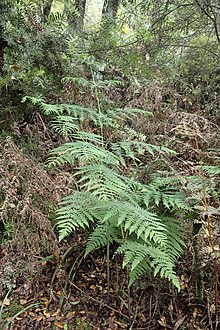
Thelypteridaceae is a family of about 900 species of ferns in the order Polypodiales. In the Pteridophyte Phylogeny Group classification of 2016, it is placed in the suborder Aspleniineae. Alternatively, the family may be submerged in a very broadly defined family Aspleniaceae as the subfamily Thelypteridoideae.
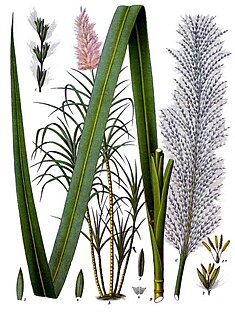
Saccharum is a genus of tall perennial plants of the broomsedge tribe within the grass family.

Pteris (brake) is a genus of about 300 species of ferns in the subfamily Pteridoideae of the family Pteridaceae. They are native to tropical and subtropical regions, southward to New Zealand, Australia, and South Africa, north to Japan and North America. 78 species are found in China. Some species of Pteris have considerable economic and ecological value, such as Pteris multifida, Pteris ensiformis, Pteris vittata can be used for ornamental purposes; as a hyperaccumulator, Pteris multifida and Pteris vittata can be used to control soil pollution.

Sanvitalia ), the creeping zinnias, is a genus of flowering plants belonging to the family Asteraceae. They are native to mostly to Mexico, with a few species in Central America, South America, and the Southwestern United States.

Microsorum is a genus of ferns in the family Polypodiaceae, subfamily Microsoroideae, according to the Pteridophyte Phylogeny Group classification of 2016 (PPG I). The species are tropical. Like most ferns, they grow from rhizomes, rather than roots. The genus name is often misspelled "Microsorium" or "Microsoreum". It includes some species that are lithophytic rheophytes.
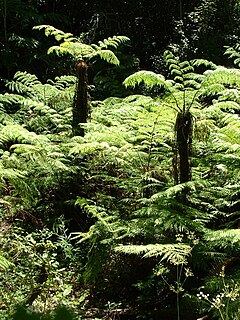
Alsophila is a genus of tree ferns in the family Cyatheaceae. It has also been considered to be a section in the subgenus Cyathea of the genus Cyathea.

Dennstaedtia is a mostly tropical and subtropical genus of ferns described as a genus in 1801. Hayscented fern, or Cup ferns, are common names for some species in this genus. Its best-known member is probably the temperate North-American hay-scented fern, Dennstaedtia punctilobula, which forms extensive clonal ground-cover colonies on level surfaces in the Appalachian area.

Sonchus arvensis, the field milk thistle, field sowthistle, perennial sow-thistle, corn sow thistle, dindle, gutweed, swine thistle, or tree sow thistle, is a species of flowering plant in the family Asteraceae. S. arvensis often occurs in annual crop fields and may cause substantial yield losses.

Tectaria is a genus of fern in the family Tectariaceae, according to the Pteridophyte Phylogeny Group classification of 2016. Halberd fern is a common name for species in this genus.

Halodule is a genus of plants in the family Cymodoceaceae described as a genus in 1841. It is widespread on tropical and semi-tropical ocean shores of all continents except Europe and Antarctica.
Gymnosperma is a genus of North American flowering plants in the family Asteraceae.
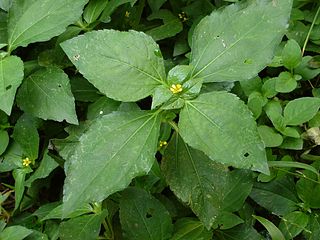
Synedrella is a genus of flowering plants in the family Asteraceae.
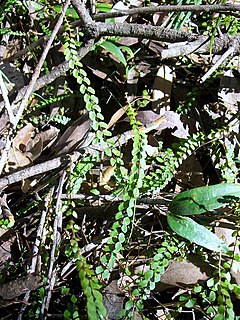
Lindsaea, common name necklace fern, is a genus of around 180 species of fern, 15 of which reach Australia. The name is in honour of surgeon John Lindsay of Jamaica. The genus is sometimes spelt Lindsaya.
Cyathea holdridgeana, synonym Cyathea albomarginata, is a species of tree fern native to Panamá and Costa Rica. It grows in wet forests at elevations of 2400–2800 m, considerably higher than most other tree ferns of Central America.

Macroscepis is a genus of plants in the family Apocynaceae, first described as a genus in 1819. It is native to Latin America and the West Indies.
Pronephrium is a genus of ferns in the family Thelypteridaceae in the family Thelypteridaceae, subfamily Thelypteridoideae, in the Pteridophyte Phylogeny Group classification of 2016. Other sources sink Pronephrium into a very broadly defined genus Thelypteris. Some species were split off into the genera Abacopteris, Grypothrix and Menisciopsis in 2021 as a result of a phylogenetic study of the family Thelypteridaceae.

Diplopterygium is a genus of ferns in the family Gleicheniaceae.
Syngramma is a genus of ferns in the subfamily Pteridoideae of the family Pteridaceae. Species are native to south-east tropical Asia and the Pacific.
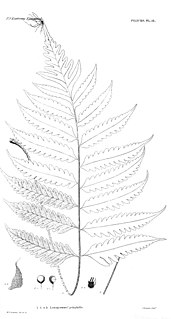
Lomagramma is a genus of ferns in the family Dryopteridaceae, subfamily Elaphoglossoideae, in the Pteridophyte Phylogeny Group classification of 2016.

Grypothrix is a small genus of ferns in the family Thelypteridaceae.
